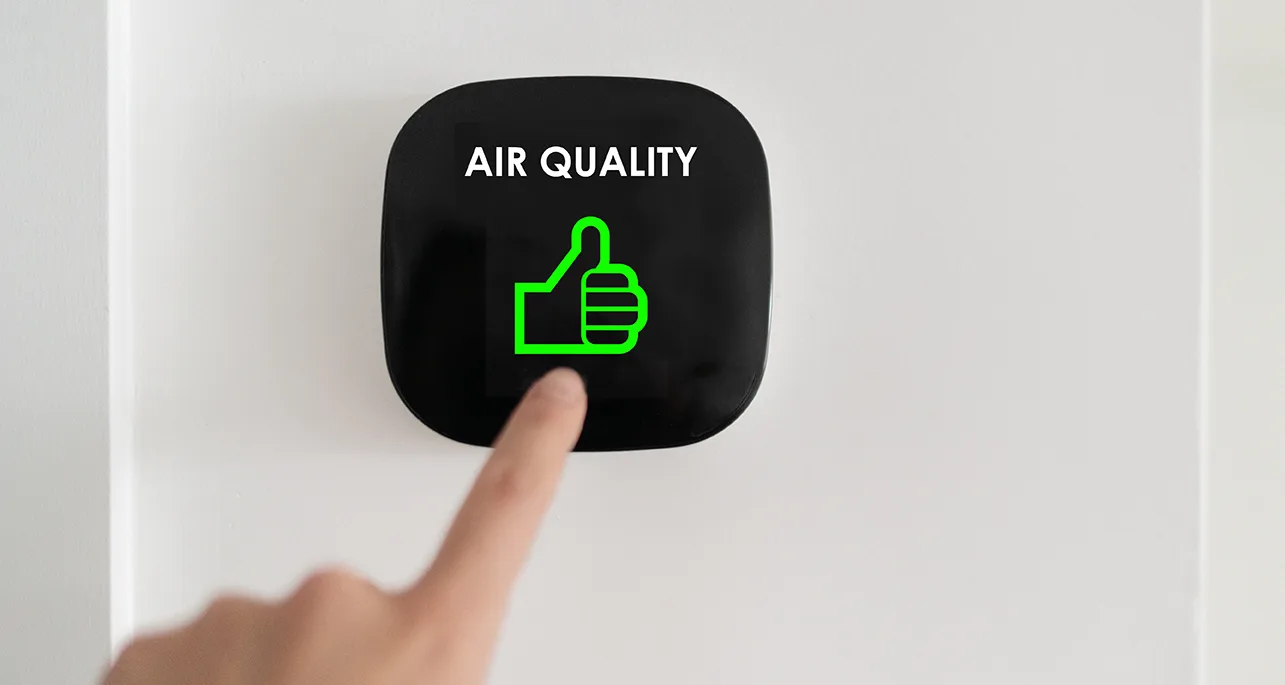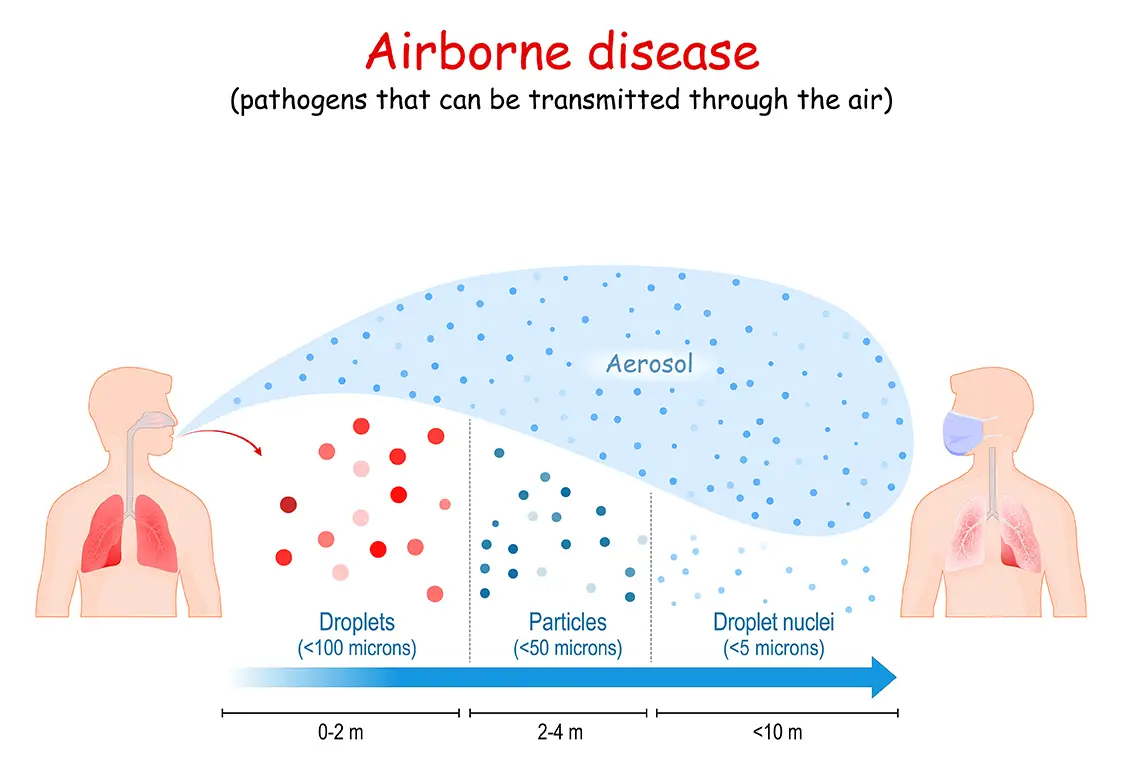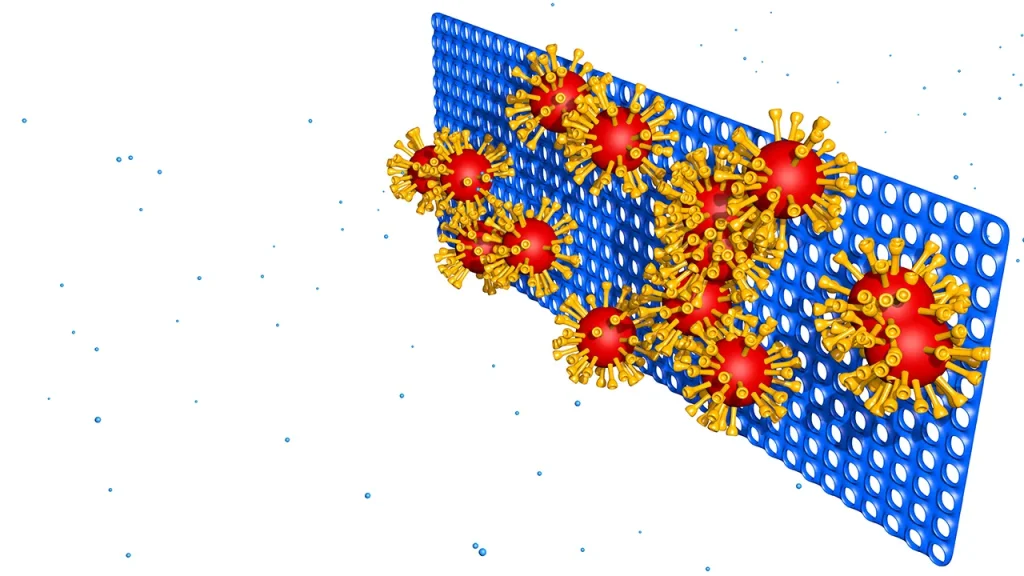
Breathing in fresh, clean air is like a secret potion for our well-being and joyous existence.
You see, the air we inhale within the walls of our cozy havens holds immense power—power that can shape our health, productivity, and overall happiness. And this is precisely where the captivating realm of air sterilization steps in, taking center stage as the ultimate guardian of clean and secure indoor spaces.
Imagine this: recent whispers from White House staff reveal a treasure trove of astonishing benefits linked to enhancing indoor air quality through building-level improvements.
Brace yourself, because we’re about to unveil a groundbreaking revelation. This incredible method not only thwarts the spread of pesky airborne diseases like COVID-19 but also boosts your brainpower, supercharges your productivity, and forms an impenetrable shield against other airborne biological contaminants.
Oh, and let’s not forget about health equity—air sterilization ensures that every single soul, including our cherished essential workers and vulnerable communities, can savor the sweet taste of a healthier life.
Now, get ready to dive into the depths of our comprehensive guide—a guide that will whisk you away into a world where air sterilization reigns supreme. Together, we’ll explore effective methods to transform your indoor air into a sanctuary of pristine purity.
Are you prepared to witness the extraordinary impact this simple yet potent approach can have on your daily life? Buckle up, my friend, as we embark on this thrilling journey, breathing in the remarkable magic of clean air, one breath at a time.

In the quest for pure indoor air, it’s crucial to grasp the essence of air sterilization and its profound importance.
Air sterilization is the art of vanquishing a minimum of 99.9999% of pathogens, viruses, and other biological contaminants that infest the air we breathe. It’s a powerful process that neutralizes or annihilates these invisible adversaries, paving the way for a healthier and safer environment.
Unlike mere air filtration, which battles against larger particles, air sterilization takes the fight to a whole new level. It specifically targets the unseen troublemakers—viruses, bacteria, and even hardy spores—that pose a threat to our well-being.
Imagine air sterilization as a caped crusader, bravely standing against airborne diseases and pathogens. It acts as a resilient shield, actively eradicating potential risks that hide within the air we inhale—especially significant during the times of the notorious COVID-19 pandemic.

By integrating air sterilization into our indoor domains, we can dramatically curtail the transmission of infectious diseases and lessen the impact of respiratory irritants. This not only safeguards our personal health but also nurtures a secure and salubrious atmosphere for our loved ones, colleagues, and communities.
While air filtration holds undeniable importance in maintaining indoor air quality, it’s crucial to recognize the added wonders of air sterilization. By distinguishing between these two approaches, we empower ourselves to make well-informed decisions about the most effective strategies to achieve and maintain pristine indoor air. So, buckle up as we delve deeper into the only current method employed for air sterilization and unravel the astonishing benefits the technology bestows. Stay tuned for the upcoming sections, where we’ll explore this system and its transformative potential on your journey to superior indoor air quality.
When it comes to ensuring clean indoor air, air sterilization offers a plethora of benefits that contribute to a healthier, safer, and more comfortable environment. Let’s dive into the key advantages of air sterilization:
Protecting against airborne diseases: Air sterilization plays a vital role in safeguarding individuals from the likes of COVID-19 and other respiratory illnesses. By eliminating harmful pathogens from the air, it reduces the risk of infection and cross-contamination within enclosed spaces.
Reducing the risk of infections: By actively targeting and neutralizing pathogens, air sterilization helps curtail the spread of infectious diseases. This is particularly crucial in places where people gather such as offices, schools, hospitals, and public spaces.
Creating a safe haven: Air sterilization creates a sanctuary for individuals with weakened immune systems, such as the elderly or those with chronic health conditions. By minimizing the presence of harmful microorganisms in the air, it provides an additional layer of protection and peace of mind.
Promoting cognitive function and productivity: Clean air plays a vital role in enhancing cognitive function and productivity. With improved air quality through sterilization, individuals experience better focus, concentration, and mental clarity. This is especially valuable in work and educational settings where productivity and performance are paramount.
Supporting a good night’s sleep: Clean air is crucial for a restful sleep. By eliminating airborne irritants and cultivating a healthier sleep environment, air sterilization contributes to a better quality of sleep. This, in turn, positively impacts overall health, mood, and daily functioning.
Investing in air sterilization technologies brings forth these invaluable benefits that are vital for a healthy and thriving indoor environment. From shielding against airborne diseases to improving air quality and enhancing productivity and well-being, the significance of air sterilization cannot be overstated. By embracing air sterilization, you can create a safer, cleaner, and more comfortable space for yourself, your family, and all occupants of the indoor environment.
When it comes to ensuring clean indoor air, a variety of methods have emerged as effective approaches for improving air quality. Let’s embark on a journey to explore some of the most common methods, uncovering their benefits and limitations:
Harnessing the might of ultraviolet (UV) light: UV-C light, a specific wavelength of Ultraviolet light, wields the power to exterminate microorganisms such as bacteria, viruses, and mold spores. UV-C light systems emit this potent light to neutralize pathogens in the air.
Exploring effectiveness and applications: UV-C light has exhibited promising outcomes in environments where air quality is paramount, such as hospitals, laboratories, and bustling areas. By continuously disinfecting the air, UV-C light aids in reducing the transmission of airborne diseases and upholds a healthy indoor environment.
Drawbacks and Limitations of UV-C Light:
Unleashing the prowess of UV light and a catalyst: PCO technology marries UV light and a catalyst, often titanium dioxide (TiO2), to generate hydroxyl radicals and reactive oxygen species. These reactive molecules neutralize pollutants, organic compounds, and microorganisms in the air.
Highlighting benefits and limitations: PCO systems proficiently eliminate a wide array of contaminants, including volatile organic compounds (VOCs), odors, and pathogens. Nevertheless, the efficiency of PCO can fluctuate based on factors like airflow, catalyst quality, and maintenance. Ensuring proper system design and regular cleaning is crucial to maintain peak performance.
Unraveling the secrets of advanced filtration systems: High-Efficiency Particulate Air (HEPA) filters have gained renown for their ability to capture and remove airborne particles as minuscule as 0.3 microns with remarkable efficiency. These filters employ a dense web of fibers to ensnare contaminants, including allergens, dust, pet dander, and even certain bacteria and viruses.
Understanding contaminant removal: HEPA filters act as a physical barrier, mechanically trapping particles as air traverses the filter. This filtration method proves highly effective in reducing pollutant concentration, enhancing air quality, and providing respite for individuals with respiratory conditions.
Drawbacks and Limitations of HEPA filters:

Frequent Filter Replacement and HVAC Configuration: HEPA filters require regular replacement to maintain optimal performance. Depending on the environment and level of particulate contamination, filter replacements can be relatively frequent, resulting in additional maintenance costs. Additionally, integrating HEPA filters into existing HVAC systems may require modifications or upgrades to ensure proper airflow and filter efficiency.
Unveiling the wonders of ionizers and negative ions: Ionization technologies release negative ions into the air, which attach to airborne particles, causing them to coalesce and settle on surfaces or the ground. This process effectively rids the breathing zone of these particles.
Exploring effectiveness and health considerations: Ionizers prove invaluable in improving air quality, particularly in diminishing the concentration of fine particles. However, it’s important to consider potential health implications associated with ionization methods. While negative ions can positively impact air quality, some studies suggest that excessive negative ions may provoke respiratory irritation in sensitive individuals. Adhering to recommended guidelines and ensuring proper ventilation is vital when utilizing ionization technologies.
Drawbacks and Limitations of Ionization Technologies:
In the realm of air sterilization, SteriSpace emerges as a groundbreaking solution that redefines the concept of true air sterilization. Let’s delve into the innovative mechanism of SteriSpace and explore why it stands out as the optimal choice for achieving unparalleled air quality.
With many people spending as much as 90% of their time inside, clean indoor air is critical to your health. Airborne illnesses tend to spread much more rapidly indoors. This is especially true if the area is poorly ventilated.
That is why many organizations are turning to air sterilization systems like SteriSpace air sterilization technology. These systems provide a deeper clean than air purification, removing dangerous pathogens from the air. This reduces airborne transmission and airborne dissemination of viruses like COVID-19. In addition, early research indicates that air sterilizers might help:
Air sterilization is a cost-effective solution for healthcare settings and corporate settings. Keep reading to learn more.
At the core of SteriSpace lies a patented compressive heating technology that sets it apart from traditional air sterilization methods. The system operates by heating a continuous volume of airflow to a treatment temperature of 464°F (240°C). Let’s take a closer look at how SteriSpace achieves its remarkable results:
SteriSpace offers versatility and scalability, making it suitable for various applications and enclosed spaces. The technology can accommodate airflows ranging from 150 to 5000 cubic feet per minute (CFM). Positive displacement blowers and superchargers are utilized for lower flow rates (150 CFM to 500 CFM), while high-pressure fans cater to higher-volume airflows (1200 CFM to 5000 CFM).
Additionally, SteriSpace can be seamlessly integrated with existing air handling systems through ducting. By connecting SteriSpace to the return vent and providing sterile air back into the supply vent, it enhances the indoor air quality without requiring significant infrastructure changes. This integration allows for the effective sterilization of the air and contributes to overall improved air quality within the enclosed space.
SteriSpace presents a modular air solution that can be incorporated into a wide range of building applications. By including SteriSpace as an additional sub-assembly in commercial rooftop air conditioning units and air handling units, the system enhances air sterilization and reduces the need for separate components like fan modules and heating coils.
Moreover, SteriSpace synergistically complements High-Efficiency Particulate Air (HEPA) filters. While HEPA filters efficiently capture aerosolized microorganisms, they can become breeding grounds for microbes when suitable temperature and humidity conditions are present. SteriSpace significantly reduces the microbial bioburden on HEPA filters, improving their performance and extending their lifespan. This combined approach ensures superior air purification and a safer indoor environment.
Ensuring clean and safe indoor air is crucial in various market sectors, where the transmission of airborne diseases can pose significant risks to vulnerable populations. In this section, we will explore the applications of air sterilization in healthcare, military and government facilities, as well as schools, highlighting the importance of implementing effective air treatment systems for enhanced protection and well-being.
In the realm of healthcare, the need to safeguard patients from airborne diseases has never been more pressing. Hospitals and medical facilities, already burdened with ailing patients, face the constant threat of infectious diseases spreading rapidly through the air. Recent outbreaks like SARS-CoV-2 serve as stark reminders of the potential for airborne transmission, which can have devastating consequences.

Airborne diseases, such as Chickenpox, Influenza, Measles, Smallpox, and Tuberculosis, have the ability to propagate through the air, posing significant risks within healthcare settings. Furthermore, there is evidence of airborne nosocomial transmission of Healthcare Associated Infections (HAIs) like Acinetobacter, Pseudomonas, and Methicillin-resistant Staphylococcus aureus (MRSA), contributing to a staggering number of fatalities annually.
“The inclusion of this technology in the Schoellkopf facility is critical because we all know what happened over the course of the last several years. You have this airborne problem that attacks our most vulnerable, which includes the elderly.”
Mayor Robert Restaino, Niagara Falls NY
Airborne transmission occurs when individuals have direct or indirect contact with one another, especially when they lack immunity. Caretakers who neglect proper hand hygiene run the risk of contracting infections through direct touch. Additionally, large infectious aerosols can swiftly travel from the source to the receptor, serving as a prevalent means of direct contact transmission. However, it is the indirect contact method of airborne transmission that poses a significant challenge. Tiny aerosols, skin flakes, and fungal spores can be disseminated in indoor air over long distances and durations, increasing the risk of infection. Aerosols can be produced through talking, coughing, sneezing, shedding skin, and resuspension from surfaces.
Given these risks, healthcare facilities must be equipped to handle the most severe situations and prevent the airborne spread of diseases. Traditional industry standards for cleanliness have limited impact on mitigating the transmission of airborne pathogens. However, SteriSpace presents a breakthrough solution as the only air treatment system capable of achieving “air sterilization.” By implementing SteriSpace technology, healthcare facilities can significantly enhance their ability to safeguard patients and healthcare workers alike.
The applications of air sterilization extend beyond the healthcare sector, finding critical relevance in military and government settings. Government buildings, command centers, and mail rooms are at constant risk of contamination by airborne biological agents, including bacterial spores, viruses, and bacteria. SteriSpace offers unparalleled protection against these threats, making it an indispensable tool in biosecurity and biosafety measures.
Originally designed to mitigate biological warfare agents, SteriSpace’s robust capabilities ensure the removal of biological contaminants and enhance protection against airborne pathogens. Military personnel operating in expeditionary environments face unique challenges and risks, necessitating advanced air sterilization technologies. By integrating SteriSpace into military command centers, shelters, and rapid-deployment facilities, biological hazards can be effectively neutralized, safeguarding the health and well-being of military personnel and government officials.
The U.S. Department of Defense recognizes the importance of biosafety and biosecurity innovations, positioning SteriSpace as an ideal solution for protecting government facilities. By deploying multiple units and connecting them in parallel, buildings of various sizes can benefit from the elimination of biological threats and the provision of cleaner air. Whether in government offices, emergency shelters, or during flu epidemics and pandemics like the recent COVID-19 crisis, SteriSpace offers critical support in ensuring the safety and protection of military and government personnel.
Creating a healthy and safe environment for students is paramount to their overall well-being and academic success. Extensive scientific research has shown that the physical and social environment in schools significantly impacts children’s health and learning capacities. However, the maintenance of safe learning environments, including air quality, is often not given the attention it deserves.
Many schools fail to meet adequate standards for environmental conditions, with poor indoor air quality (IAQ) being a prevalent issue. Insufficient ventilation, irritants, and airborne pathogens can negatively impact IAQ, leading to a range of health consequences for students and staff. Poor IAQ contributes to respiratory diseases, increasing the incidence of infections and absenteeism. In fact, respiratory illnesses exacerbated by poor IAQ result in millions of missed school days annually.

To address these challenges, SteriSpace technology plays a crucial role in ensuring a healthy and safe learning environment for students. By effectively eliminating 99.9999% of airborne pathogens, SteriSpace provides an unparalleled level of protection. This technology enables schools to avoid shutdowns by utilizing designated isolation rooms that are properly equipped with air sterilization systems.
By combining air sterilizationr through SteriSpace with the maintenance of negative pressure in isolation rooms, schools can achieve true infection control. Creating a negative pressure environment helps isolate infected individuals, reducing the likelihood of further transmission among healthy students and staff. While many schools rely on isolation rooms and personal protective equipment (PPE) to mitigate the spread of infectious pathogens, optimizing these rooms with air sterilization systems significantly enhances infection containment and overall safety.
In conclusion, the market applications of air sterilization also extend to transportation, hospitality, agriculture, and more. These sectors recognize the critical importance of protecting individuals from airborne diseases and contaminants. SteriSpace technology emerges as a game-changing solution, offering “air sterilization” capabilities that surpass traditional methods. By embracing advanced air treatment systems, these markets can create safer and healthier environments, ensuring the well-being and security of individuals in their care.
In our quest for clean and safe indoor environments, air sterilization takes center stage. The significance of ensuring optimal air quality cannot be overstated. By prioritizing air sterilization methods, we can create healthier living and working spaces, safeguarding our well-being.
As we conclude this exploration of air sterilization, it is crucial to emphasize the role of innovative solutions like SteriSpace in achieving true air sterilization. With its cutting-edge compressive heating technology, SteriSpace revolutionizes the way we purify the air we breathe. Its proven effectiveness against a wide range of pathogens and seamless integration with existing HVAC systems make it an unparalleled choice.
To learn more about SteriSpace and its potential to transform your indoor air quality, schedule a call with me, Joe Healy. Take the first step towards creating a cleaner and safer environment by reaching out today.
